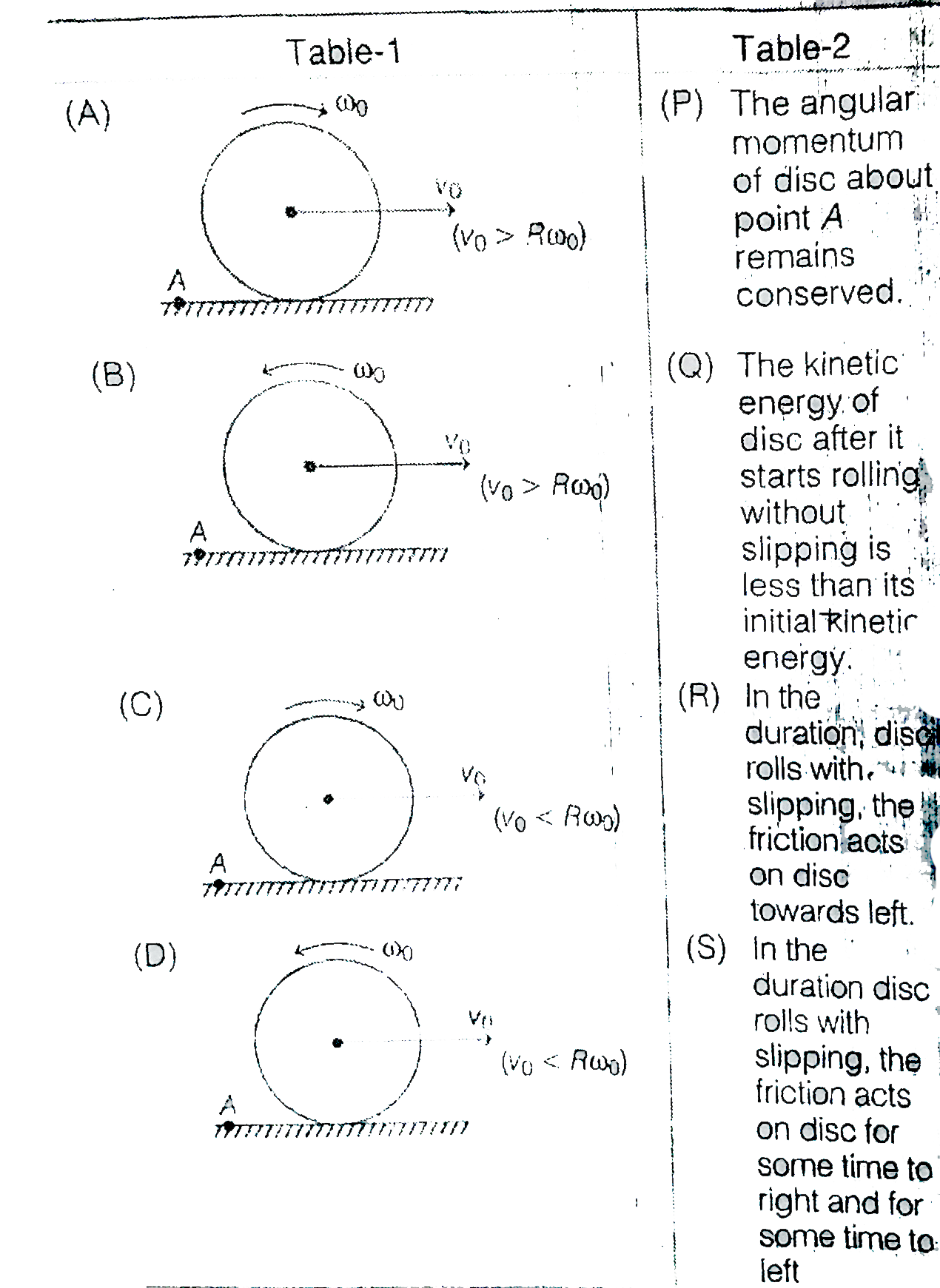A solid and a hollow sphere are released from the top of a sufficiently rough inclined plane. The solid sphere has same mass but its radius is half of the radius of hollow sphere. Both are performing pure rolling Which of the following statements is correct regarding their kinetic energy when they reach at the bottom of plane? (K = Kinetic energy)
Khollow<Ksol
Khollow=Ksol
Khollow=2Ksol
Khollow>Ksol
To solve the problem, we need to analyze the kinetic energy of both the solid and hollow spheres when they reach the bottom of the inclined plane. Let's break it down step by step.
Step 1: Understand the Moment of Inertia
The moment of inertia (I) is crucial in determining how the potential energy converts into kinetic energy for both spheres.
- For a solid sphere:
Is=25mr2
- For a hollow sphere:
Ih=23mR2
where r is the radius of the solid sphere and R is the radius of the hollow sphere.
Step 2: Relate Angular Velocity and Linear Velocity
Since both spheres are rolling without slipping, we can relate their angular velocity (ω) to their linear velocity (v):
ω=vr(for the solid sphere)
ω=vR(for the hollow sphere)
Step 3: Conservation of Energy
The potential energy at the top of the incline is converted into kinetic energy at the bottom. The total kinetic energy (K) consists of translational and rotational components:
mgh=12mv2+12Iω2
Step 4: Calculate for the Solid Sphere
Substituting the moment of inertia and angular velocity for the solid sphere:
mgh=12mv2+12(25mr2)(v2r2)
Simplifying:
mgh=12mv2+15mv2
mgh=(510+210)mv2=710mv2
Thus:
gh=710v2⇒v2=10gh7
Step 5: Calculate for the Hollow Sphere
Now, for the hollow sphere:
mgh=12mv2+12(23mR2)(v2R2)
Simplifying:
mgh=12mv2+13mv2
mgh=(36+26)mv2=56mv2
Thus:
gh=56v2⇒v2=6gh5
Step 6: Compare Kinetic Energies
The kinetic energy (K) can be expressed as:
K=12mv2
For the solid sphere:
Ks=12m(10gh7)=5mgh7
For the hollow sphere:
Kh=12m(6gh5)=3mgh5
Step 7: Determine Which is Greater
To compare Ks and Kh:
- Convert Kh to have a common denominator:
Kh=3mgh5=3⋅7mgh35=21mgh35
- Convert Ks:
Ks=5mgh7=5⋅5mgh35=25mgh35
Now we can see:
Ks=25mgh35andKh=21mgh35
Thus:
Ks>Kh
Conclusion
The correct statement is that the kinetic energy of the solid sphere is greater than that of the hollow sphere when they reach the bottom of the inclined plane.
The moment of inertia (I) is crucial in determining how the potential energy converts into kinetic energy for both spheres.
Is=25mr2
- For a hollow sphere:
Ih=23mR2
where r is the radius of the solid sphere and R is the radius of the hollow sphere.
Since both spheres are rolling without slipping, we can relate their angular velocity (ω) to their linear velocity (v):
ω=vr(for the solid sphere)
ω=vR(for the hollow sphere)
The potential energy at the top of the incline is converted into kinetic energy at the bottom. The total kinetic energy (K) consists of translational and rotational components:
mgh=12mv2+12Iω2
Substituting the moment of inertia and angular velocity for the solid sphere:
mgh=12mv2+12(25mr2)(v2r2)
Simplifying:
mgh=12mv2+15mv2
mgh=(510+210)mv2=710mv2
Thus:
gh=710v2⇒v2=10gh7
Now, for the hollow sphere:
mgh=12mv2+12(23mR2)(v2R2)
Simplifying:
mgh=12mv2+13mv2
mgh=(36+26)mv2=56mv2
Thus:
gh=56v2⇒v2=6gh5
The kinetic energy (K) can be expressed as:
K=12mv2
For the solid sphere:
Ks=12m(10gh7)=5mgh7
For the hollow sphere:
Kh=12m(6gh5)=3mgh5
To compare Ks and Kh:
- Convert Kh to have a common denominator:
Kh=3mgh5=3⋅7mgh35=21mgh35
- Convert Ks:
Ks=5mgh7=5⋅5mgh35=25mgh35
Ks=25mgh35andKh=21mgh35
Thus:
Ks>Kh
The correct statement is that the kinetic energy of the solid sphere is greater than that of the hollow sphere when they reach the bottom of the inclined plane.
Topper's Solved these Questions
Similar Questions
A solid sphere hollow sphere disc, ring and hollow cylinder are relased from the top of a fixed inclined when all of them have same mass and radius

View SolutionA solid sphere, a hollow sphere, a solid disc and a hollow cylinder are allowed to roll down a sufficiently rough inclined plane starting from rest. All have same mass and radius.

View SolutionA hollow spherre is released from rest on a rough inclined plane as shown in the figure. Find the velocity of point of contact as a function of time. ( m = mass of hollow sphere, R = radius of sphere )

View SolutionA ring, cylinder and solid sphere are placed on the top of a rough incline on which the sphere can just roll without slipping. When all of them are released at the same instant from the same position, then
View SolutionA hollow sphere and a solid sphere having same mass and same radii are rolled down a rough inclined plane.
View SolutionA hollow sphere is released from top of an inclined plane of inclination 30º and length of inclined plane is /. If sphere rolls without slipping then its speed at bottom is
View SolutionA solid sphere, a hollow sphere and a ring are released from top of an inclined plane (frictionsless) so that they slide down the plane. Then maximum acceleration down the plane is for (no rolling) :
View SolutionA solid sphere and a hollow sphere of same mass M and same radius R are released from the top of a rough inclined plane. Friction coefficient is same for both the bodies. If both bodies perform imperfect rolling, then
Statement - 1 : Work done by friction for the motion of bodies from top of incline to the bottom will be same for both the bodies.
Statement - 2 : Force of friction will be same for both the bodies.
View SolutionA ring, a solid cylinder, a hollow sphere and a solid sphere are released from rest on an inclined plane from same level. If there is no slipping then which one of these will reach the ground at last?
View SolutionA solid cylinder, a circular disc, a solid sphere and a hollow cylinder of the same radius are placed on an inclined plane. Which of the following will have maximum acceleration at the bottom of the plane?
View Solution
